Effect of a geothermal heat pump system on cooling residential buildings in a hot, dry climate
Q2 Engineering
引用次数: 0
Abstract
ABSTRACT In the last century, electricity demand has doubled due to urban expansion, which has contributed to the formation of more urban heat islands (UHI) and the appearance of environmental hazards such as the global climate change phenomenon. Since residential buildings are considered the main electricity consumer sector in Egypt, they consume up to 42% of total energy consumption, which contributes to increasing temperatures and constitutes UHI in cities. In this context, the research aims to examine the effectiveness of using the closed vertical loop geothermal system (GSHPCV) for cooling residential buildings in a hot, dry climate, such as Cairo, Egypt. In addition to determining its effect on carbon emissions and the amount of energy consumed for cooling, this was done using TRNSYS-17 software as a simulation tool to compare the traditional building in a hot, dry climate before and after adding GSHPCV in Cairo, Egypt. The simulation revealed that using GSHPCV in hot, dry climate zones has a significant impact on residential buildings. It reduced the electricity consumption up to 19.7% of the electricity consumed for cooling, and it reduced temperatures indoors for buildings up to 15.8% on the ground floor, up to 11.3% on the first floor, and up to 3.5% on the roof floor. In addition, it reduced up to 19.7% of the carbon emissions and reached human thermal comfort on the ground floor for the study case at peak times during the summer period. Which provide a solution to reduce UHI and environmental hazards such as climate change.地源热泵系统对炎热干燥气候下住宅楼制冷的影响
在上个世纪,由于城市扩张,电力需求翻了一番,这导致了更多的城市热岛(UHI)的形成和全球气候变化等环境危害现象的出现。由于住宅建筑被认为是埃及的主要电力消费部门,它们消耗了高达总能源消耗的42%,这有助于温度升高并构成城市的热岛。在此背景下,该研究旨在研究在埃及开罗等炎热干燥的气候中使用封闭垂直循环地热系统(GSHPCV)为住宅建筑降温的有效性。除了确定其对碳排放的影响和冷却消耗的能量外,还使用TRNSYS-17软件作为模拟工具来比较埃及开罗的传统建筑在炎热干燥的气候中添加GSHPCV前后的差异。模拟结果表明,在干热气候区使用GSHPCV对住宅建筑有显著影响。它减少了高达19.7%的电力消耗用于冷却,它降低室内温度的建筑物,高达15.8%的地面,高达11.3%的一楼,高达3.5%的屋顶地板。此外,它减少了高达19.7%的碳排放,并在夏季高峰时段达到了研究案例一层的人体热舒适。这为减少热岛热岛和气候变化等环境危害提供了解决方案。
本文章由计算机程序翻译,如有差异,请以英文原文为准。
求助全文
约1分钟内获得全文
求助全文

 求助内容:
求助内容: 应助结果提醒方式:
应助结果提醒方式:


